Highlights
- Hungary is experiencing some fertility gains, probably at least partly as a result of a basket of policy changes including tax preferences, cash grants, loan subsidies, and constitutional protections. Post This
- Hungary is not just experiencing a fertility spike; it's winding back the clock on much of the fertility and family-structure transition that demographers have long considered inevitable. Post This
In 2015, the government of Hungary announced a major new policy: families would be given generous subsidies to buy or build new homes, and the subsidies would scale up based on their marital status and the number of children they had. This “Family Housing Allowance Program,” or CSOK (the abbreviation of the program’s Hungarian name), gives a maximum benefit to married couples with three or more children, equivalent to a $36,000 grant to buy a new home, alongside a major value-added tax deduction for each home, and a capped-interest loan for part of the home value. These interest and tax benefits are probably worth around another $15,000 to $50,000 per family, depending on the house they buy and their likely loan terms. In other words, for a married couple buying a new house with at least three kids, the value of their total payout could run anywhere from $50,000 to $80,000. Meanwhile, for a couple with just two kids, the payout could be from around $18,000 to $35,000. In other words, that extra kid earns the family somewhere between $15,000 and $62,000 extra dollars. Given that the average salary in Hungary is only around $11,000 to $15,000 per year, an equivalently-impactful subsidy for Americans, based on our higher incomes, would need to amount to somewhere between $40,000 and $250,000.
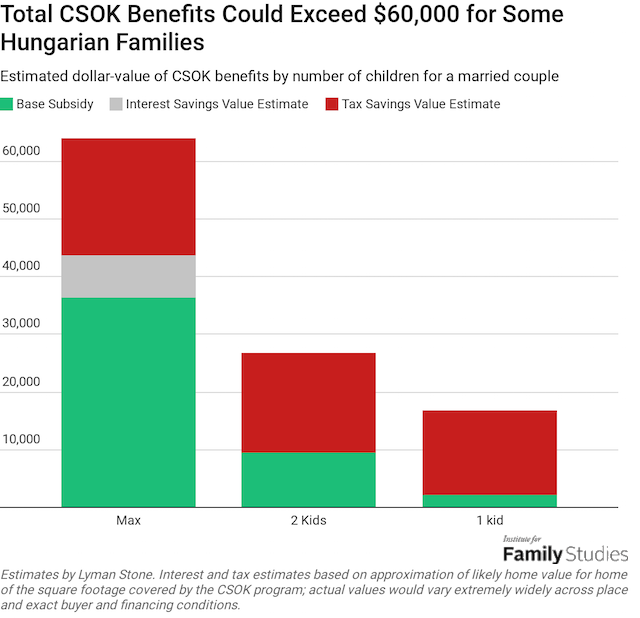
Imagine the U.S. government offered a $200,000 payout to have a third child. Do you think some people would be more likely to have that extra child? My guess is that they definitely would. I’ve written in the past that financial incentives for childbearing tend to be very expensive compared to the modest number of births they actually induce: most financial incentives are not highly effective at promoting sustainable fertility increases.
However, none of the policies I reviewed for the U.S. quite approach the magnitude suggested here: the very largest, most bold proposal for the U.S. that I’ve ever seen would be at the lower-end of the range for a Hungary-style proposal. No American policymaker has ever proposed something remotely as generous as what Viktor Orban’s Fidesz party has recently done for Hungary’s families and children. I said a similar thing in a previous piece about Poland’s right-wing populist government, which virtually ended child poverty through their generous family-support policies. Europe’s populists have babies on their mind.
But Did CSOK Actually Increase the Birth Rate?
But with all that money being spent, we may wonder: is it having any impact?
A simple chart of Hungary’s monthly births doesn’t show any obvious boom in the last few years. Zooming in to look at annual change rates in monthly births doesn’t show any stronger boom either: in fact, early 2018 appears worse than 2017 in terms of births.

But this monthly data is crude and doesn’t account for underlying population changes. To get that, we need the total fertility rate, which estimates how many children a woman entering her childbearing years in a given year can expect to have if birth rates are stable during her lifetime.
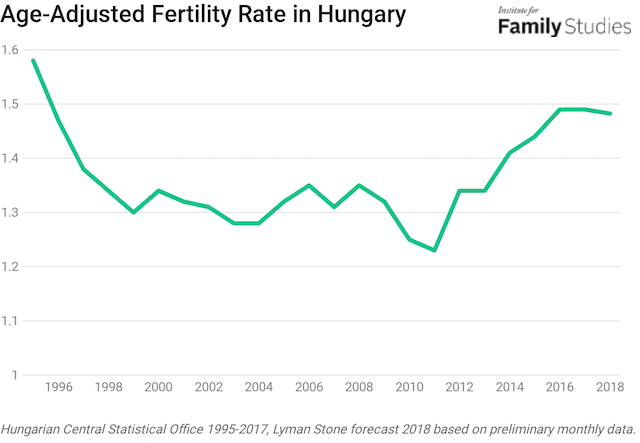
And here we see that TFR is rising quickly. That’s unusual, as most countries around the world are currently experiencing stable or falling fertility, especially in Europe. So there probably is something interesting going on in Hungary’s fertility environment, and worth exploring further. However, whatever force drove this baby boom now appears to be fading: fertility was flat in 2017, and early data for 2018 suggest that fertility may now be falling, which again suggests that CSOK has had limited effects boosting fertility in very recent years.
But we can zoom in to see how these trends shake out for the families actually targeted by the policy, that is, married families who may be interested in having higher-parity children. Hungarian birth rates by age among married women are available back to 1995. Birth rates for women in their 20s and early 30s are most interesting, as those are the age ranges most likely to be in the market for their starter home, which is about the size of the target of Hungary’s grant.
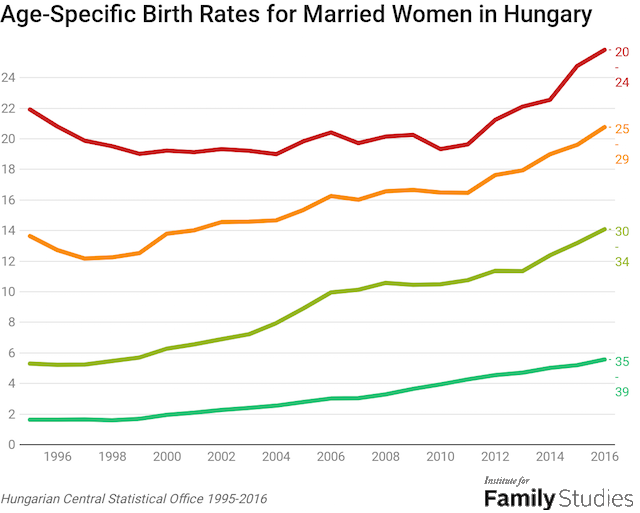
As you can see, Hungary’s married young women have seen fertility increases in recent years, and fertility for women ages 30-34 has seen particular growth. That’s consistent with these policies having some effect.
But have births mostly increased for higher-parity births? It turns out the answer is no. In fact, the number of third-or-higher parity births has fallen in the last few years, alongside rising first and second births, despite the incentive offered for third births being vastly higher than the incentive offered for first births!

In other words, the expected effect of a parity-specific incentive simply doesn’t show up. This is fairly decisive evidence against this new housing subsidy being the main driver of Hungary’s total fertility rate increase, though it is probably contributing somewhat. Added to the fact that fertility rates have actually plateaued since CSOK got into full swing in 2016, and the case for CSOK boosting birth rates looks pretty weak.
But there’s even more reason for skepticism: the increase in TFR began in 2012, well before the housing benefit began. A quick look back at the marital birth rates by age makes it quite clear that marital birth rates started their steep rise years before CSOK was implemented. In other words, this housing subsidy can’t account for the rise in fertility. While it’s entirely possible that CSOK has boosted fertility against some counterfactual where fertility would otherwise have declined, the effect is probably not very large.
Hungary’s Policy Changes Are Wide-Ranging
But that makes this next question even more interesting: if this huge cash subsidy is not causing a baby boom, what is?
First of all, in 2011 and 2012, Hungary changed the structure of their tax exemptions for children, providing new deductions that saved families between $400 and $1,500 on their tax bill per child, depending on how many kids they have. A similarly-generous deduction in the U.S., given our higher incomes and our different tax rates, would mean the introduction of a between $4,000 and $16,000 per-child tax deduction.
Previous research by academics suggests that this increased tax exemption for kids probably did boost birth rates. They estimate that the policy change caused between 6,000 and 18,000 more births from 2011 to 2013. This is strange, however, because these tax benefits are substantially smaller in their total value than CSOK. It is possible, however, that families are more responsive to tax changes than to a new program like CSOK, and couples may expect its benefits to be repealed at some point in the future, whereas tax code changes are more permanent. But taking the effect size given above for the tax changes as given, it’s possible to estimate what the trajectory of age-controlled fertility might have been in a counterfactual scenario where Hungary did not increase the generosity of its tax provisions for families.
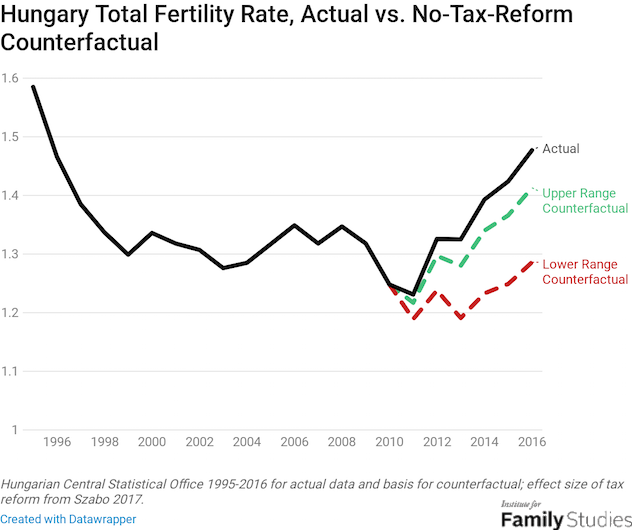
Clearly, if the academic estimates provided are at all correct, then this tax extension has had an appreciable effect on fertility and can account for a large share of the fertility increase in recent years. However, even under the largest effect estimate, tax reform cannot account for all of the increase. Even if we take the upper estimate of the tax policy change’s effect as gospel, by the end of the period, Hungary’s counterfactual fertility is rising again.
But maybe other policies changed, too. We can look at Hungary’s government data to see their total spending (not including structural elements of the tax code), on children, families, and mothers (including CSOK). My preferred way to measure this is total family and child spending, divided by the total number of children in the country, represented as a share of average national income. In other words, as wages rise, if family benefits don’t rise too, the “effective incentive” of a given benefit falls. This metric captures changes in the number of children, the surrounding economy, inflation, and policy changes.

What we can see is that family spending rose sharply from 2002 to 2009, then actually fell until 2014 by this metric, largely because the economy grew. It has spiked again more recently, thanks entirely to CSOK.
If the tax change can explain much of the fertility increase from 2011 to 2014, as it can, CSOK can probably explain some ongoing increase in 2016 and 2017. But the truth is, the fertility increase is pretty consistent across these windows of time, and it’s strange that a tax exemption would have such a strong pro-natal effect when other family spending was being cut. Rather, it may be that financial policies aren’t the only driver here.
Culture May Matter
There may be something else at work here: a marriage boom.
Starting around 2012, but really taking off in 2015 and 2016, women in Hungary started becoming more likely to get married. The marriage rates shown below reflect what share of unmarried women in a given age group the year prior got married in the last year. In most countries, this number is flat or falling, especially for younger women, as the average age of first marriage is pushed later and later. But in Hungary, the rise in the age of first marriage, which has been so inexorable in other countries, has actually stalled out and perhaps started to fall. The country is not just experiencing a fertility spike; Hungary is winding back the clock on much of the fertility and family-structure transition that demographers have long considered inevitable.
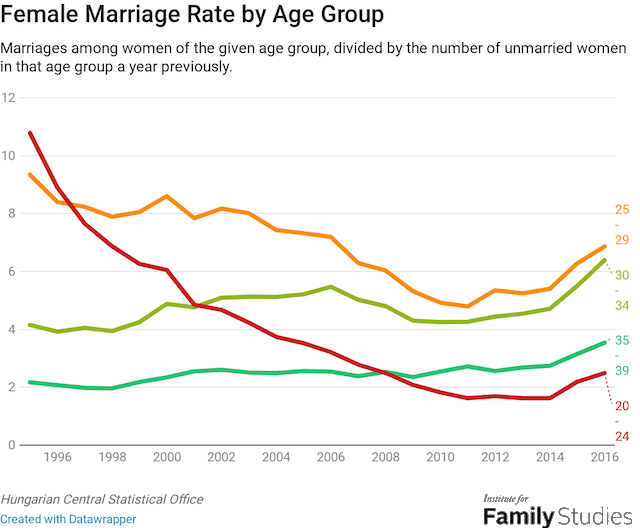
This is true even on some unfortunate metrics: unmarried teen pregnancies have risen in Hungary in recent years, even as they have fallen in other countries. Marriage rates of teen women are rising as well, which may be good, or may reflect women being relegated to homemaker roles and kept out of the public sphere, perhaps against their desires.
It’s hard to say exactly what may have driven this turnaround in marriage behaviors. Hungary was hard-hit by the Great Recession, and its GDP per capita took longer to recover to pre-recession levels than many other countries, so it probably is not due to an economic boom.
However, in 2011, Hungary adopted a new, and extremely controversial, constitution. Criticized by many international organizations as consolidating too much power around the ruling party, the document was Hungary’s first democratically produced framework for governing. It includes statements such as, “We trust in a jointly-shaped future and the commitment of younger generations. We believe that our children and grandchildren will make Hungary great again,” and, “We hold that the family and the nation constitute the principal framework for our coexistence,” and “We bear responsibility for our descendants.” It also includes strong language committing the country to historic national heritage, Christian identity, and community values. Moreover, Article L of the constitution, which, again, is the basis of Hungarian government today, says,
Hungary shall protect the institution of marriage as the union of a man and a woman… and the family as the basis of the nation’s survival. Hungary shall encourage the commitment to have children. The protection of families shall be regulated by a cardinal Act.
These changes were largely a surprise to many Hungarians, who are not, according to public surveys, an extremely religious or family-oriented people; in fact, Hungary has the third highest religiously unaffiliated population share in central and eastern Europe. But while it may have been a surprise, once implemented, constitutions can be hard to undo. Whatever exact policy details may be, Hungarians have a durable commitment from their government to make sure that some kind of family support will always exist: it’s written in the constitution! Given the long-term nature of child-rearing, this guarantee may be very important and serve as a positive shock to the long-run family expectations of Hungarian women.
It’s also possible that the proclamation of a constitution so directly aimed at ginning up national feeling, a sense of connectedness to heritage, and a promotion of the family has its own cultural effect. I’ve shown before that “cultural policies” can have large effects on childbearing and marriage: it’s possible that Hungary’s constitutional change is a kind of cultural signal to Hungarians, urging them to adopt somewhat different values.
But this direct cultural signaling effect isn’t extremely likely. Hungary’s policy changes, at least through 2013 (the most recent data available), did not result in rising fertility ideals.
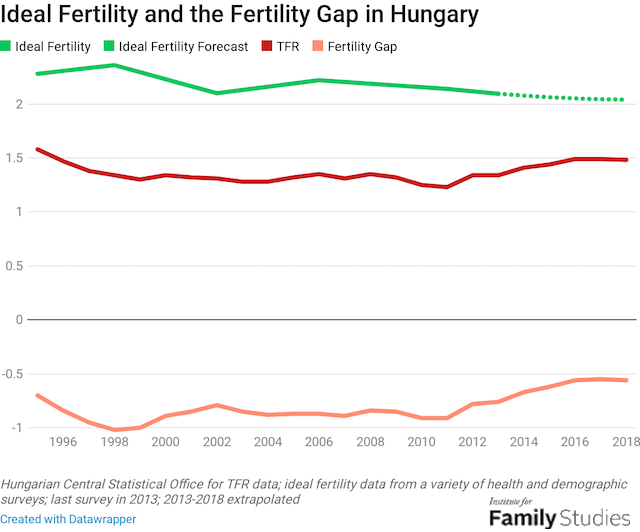
Indeed, if anything, desired childbearing in Hungary is falling! The last data point I could find is in 2013, but at least at that time, desired fertility was continuing its steady slope downwards.
If that downward trend in ideals has continued, then the “fertility gap” between current birth rates and current ideals in Hungary is shrinking, which is exactly what we might expect if marriage rates are rising, since marriage is the decisive force shaping fertility achievement. In other words, to the extent that Hungary’s tax changes or subsidies through CSOK impacted fertility, and to the extent that cultural norms propagated in Hungary’s new constitution may matter, it’s probably not through the direct incentivization of childbearing, but through the indirect incentivization of marriage. And marriage makes childbearing much more likely among the vast majority of women who desire to have kids.
By providing a grant for married couples with children, CSOK incentivizes childbearing, sure, but it also gives couples the financing they need to get a new home and live together, provided they are willing to get hitched. Hungary’s tax benefits favor families with children, and favor married filers with children the most. Beyond the direct natality incentive, these policies may induce more marriages, and with more marriages, you get more births of all kinds, including first and second kids, despite the much smaller CSOK subsidies than what is offered for a third child.
Hungary’s fertility rates are still extremely low: only about 1.5 children per woman. The government is spending huge amounts of money and will probably never reach replacement-rate with this strategy. However, Hungary is experiencing some fertility gains, probably at least partly as a result of a basket of policy changes including tax preferences, cash grants, loan subsidies, constitutional protections, and costly political signaling. But to the extent these policies are working, they are effective because they are not being used in isolation, but rather together as a whole concert of pro-natal policies and cultural nudges. And they are working because they induce marriage, not simply childbearing, and marriage helps boost long-run fertility, not just birth-timing.
Lyman Stone is a Research Fellow at the Institute for Family Studies. He blogs about migration, population dynamics, and regional economics at In a State of Migration.













